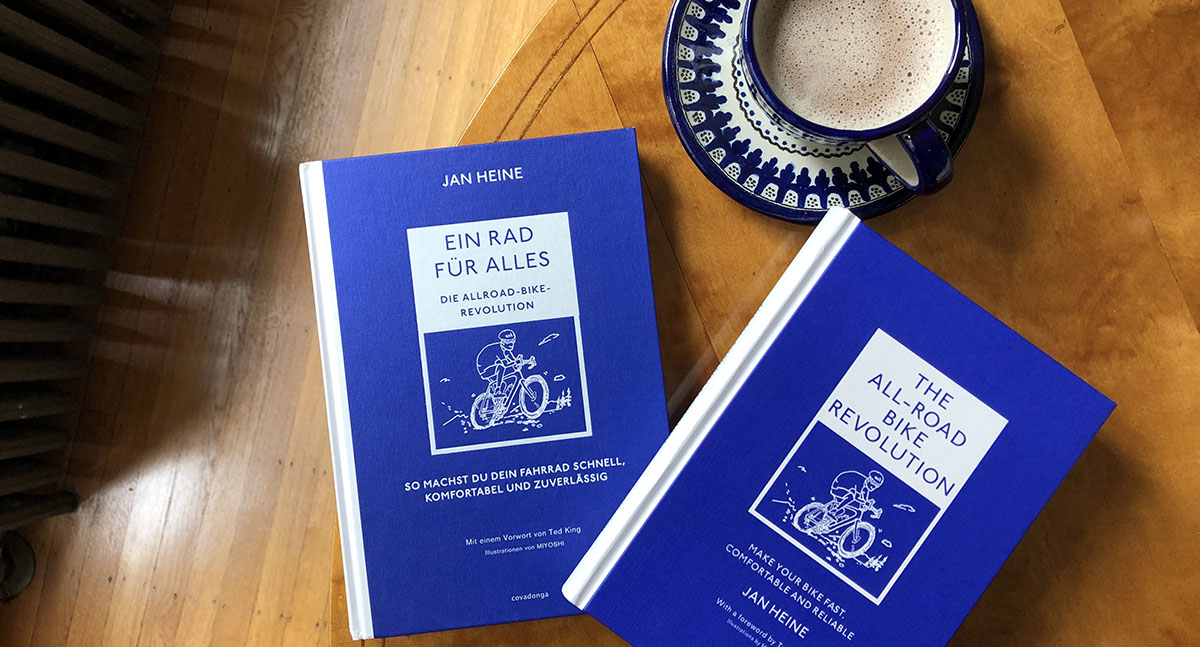All-Road Interview in DIE ZEIT
“Racing bikes are defined by the riding experience, not by a few millimeters in tire width,” says Jan Heine.
The German edition of our book ‘The All-Road Bike Revolution’ just launched, and there’s been a lot of interest in the German media. Gravel bikes are a brand-new phenomenon in Germany, at least as far as mainstream cycling is concerned, and many cyclists remain skeptical. Is this just another marketing-driven fad? Can a gravel bike really bring the same joy as gliding along on a narrow-tire racer?
I really enjoyed sitting down (remotely) with renowned German cycling journalist Tim Farin in an interview for Germany’s leading newspaper, Die ZEIT. Tim played the role of the die-hard defender of narrow-tire race bikes, of shaved legs and minimal kit, of the status quo – somewhat tongue-in-cheek, of course. It’s a different perspective from the U.S., where gravel bikes are totally accepted, but that’s exactly why some of the questions dug into things that we tend to overlook with familiarity. (Translated and republished with permission. Click here for the German original.)

“Wide Tires Save a Third of Your Power“
You ride faster on narrow tires than on wide ones? Long disproven, says cycling expert Jan Heine. For most people, a gravel bike is the best choice.
Interview by Tim Farin
For performance-oriented riders, gravel bikes have become the top category in recent years. They combine the speed of racing bikes with the ability to ride off-road. Jan Heine is considered one of the pioneers of this movement – and he’s just written a book that explains why all-road bikes can replace many other models.
ZEIT: Mr. Heine, why should I replace my carbon aero road bike with a strange-looking all-road bike?
JH: Road cyclists can be stuck in prejudices, but I don’t want to persuade you. Instead I invite you to look at the science. And then it becomes quite simple: For most spirited rides you’ll be happy with one bike, whether you call it gravel bike or, as I prefer, all-road bike. It’s really a simple equation: Comfort and performance aren’t opposed to each other any longer – quite to the contrary. All-road bikes have brought about a revolution in how we ride bikes. We shouldn’t underestimate that – it’s already happening.
ZEIT: Doesn’t this trend diminish the tough and fast sport of road cycling?
JH: 20 years ago, when I was still racing, we’d never have accepted a bike with 28 mm tires and compact cranks as a ‘real’ racing bike. From that perspective, yesterday’s gravel bike is today’s racing bike. I think this trend will continue in the future. In a few years, nobody will think a racing bike with 45 mm-wide tires is somehow odd. And when you look at most road bikes out there, they aren’t real Tour de France racers any longer. Most riders need a more upright, more comfortable riding position. We should accept this reality and pursue it to its logical conclusion. Racing bikes are defined by the riding experience, not by a few millimeters in tire width.
ZEIT: That means that we may test optimized and ultralight carbon race bikes in the wind tunnel, but we should sacrifice all those gains so we can roll on wide tires through the forest?
JH: The race bike may have great results in the wind tunnel, but that’s misleading. Most relevant is the wind resistance of the rider. We tested that in the wind tunnel. The tall, broad-shouldered human is much more important than the bike. Of course, you ride differently on a forest path than on the highway, but that’s intentional. The all-road bike was conceived to add to the possibilities for spirited riding, so you’re not just limited to smooth asphalt.
ZEIT: At the Tour de France, even today the riders are on relatively narrow tires, 25 mm, maybe 28 mm max. Tire pressures are high. On gravel bikes I see monstrously wide tires with lots of tread and low pressure. That has to kill the dynamic feel of the bike!
JH: That’s simply not true, but it’s taking a long time until this really becomes generally accepted. Wide high performance tires roll as fast as narrow ones, even on smooth roads. That has been shown multiple times. However, it is true that, if we inflate your tires to boneshaking pressures, we initially feel faster. You also have to consider that pro racers have a lot of power and usually ride on freshly repaved roads. In that scenario, we don’t need 38 mm tires. But even today’s 25 mm tires are already much wider than the 19 or 20 mm tires that we rode just 20 years ago. If you put your bike on a lab test rig, it’ll roll faster with harder tires. But when you roll on rough asphalt, with little holes and undulations – all those things cause vibrations. And the harder we inflate our tires, the more those vibrations brake us. That cancels out the benefit of the higher pressure.
ZEIT: How so?
JH: In our bodies, these vibrations cause friction between muscle tissues and thus consume power. We tested that on those rumble strips they put on the edge of our roads here in the U.S., so drivers who nod off don’t crash into the ditch. With narrow tires and 7 bar [100 psi] pressure, we needed 480 Watt to pedal the bike. At the same speed with wide tires and 3 bar [45 psi], we only needed 310 Watt. The wide tires reduced the power by a third! Rumble strips may be an extreme case, but even on normal backroads, riders like me go faster on 38 mm tires at 3 bar [45 psi] pressure – with less pain, more fun and a greater choice of routes.
ZEIT: Why do you prefer the name All-Road instead of Gravel Bike?
JH: The term ‘gravel’ is too limiting. It’s not just about riding on gravel – we enjoy riding on smooth pavement, too, but also on unpaved roads, mountain passes, and in the forest. At first we tried that with racing bikes, but it was pretty bumpy. Then I found a mid-century French bike developed for riding in the Alps. That had 38 mm tires, which was great for the mountain roads of the time that weren’t paved yet. Even 80 years ago, there were performance bikes that really could be called gravel bikes.
ZEIT: But at least they didn’t have all those bags on the frame that we often see on gravel bikes today. Is that really necessary?
JH: There’s certainly an element of marketing. Bikepacking allows selling more bags than you need for a day ride in the forest. On the other hand – how far do you usually go on your rides?
ZEIT: About 100, 120 kilometers (65-75 miles).
JH: So you’re out for three to four hours. Now imagine heading to the mountains for an all-day ride. You should bring a rain jacket and a long-sleeve jersey, because up there on the passes, it can be chilly. You also bring a little more food, because the most beautiful gravel passes don’t have convenience stores. But I agree: If you hang a dozen bags on your bike to ride 40 km (30 miles) around the city, then that’s more a fashion statement.
ZEIT: Do you agree that bags on the bike ruin the feel of a road bike?
JH: Large seat bags do change the feel of the bike, especially when you climb out of the saddle. But there are bags that allow spirited riding and don’t change the feel of the bike, for example, handlebar bags. Finally, it’s also a question of aesthetics, of what you prefer.
ZEIT: Boxy bags must be bad for the aerodynamics?
JH: We tested that in the wind tunnel, too. It depends on the bags and the riding position. Some bags can have a positive effect – like an aerodynamic fairing.
ZEIT: Can we really accept the gravel bike as a racing bike?
JH: The bike industry hasn’t really provided a clear answer to that question. When you shop for a gravel bike, you’ll find very different models. Some have a very performance-oriented riding position; others are less designed for spirited riding. In our book, we talk about how to increase the usability of a road bike, without losing the feel and fun that make a road bike special. After all, there are real gravel races now, where you’ll even see professional racers participate. That’s not just a casual outing to a nice picnic spot. At the same time, this comfortable, yet sporting, riding style has the potential to bring many new cyclists into our sport.
Further reading:
• More information about our book ‘The All-Road Bike Revolution.’



